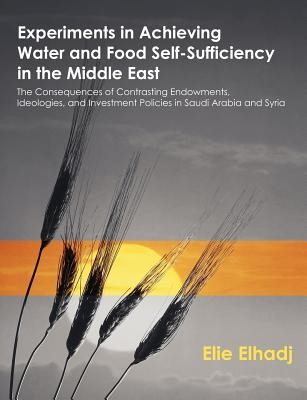
- We will send in 10–14 business days.
- Author: Elie Elhadj
- Publisher: Dissertation.Com. - Do Not Use
- ISBN-10: 1581122985
- ISBN-13: 9781581122985
- Format: 18.9 x 24.6 x 1.1 cm, minkšti viršeliai
- Language: English
- SAVE -10% with code: EXTRA
Experiments in Achieving Water and Food Self-Sufficiency in the Middle East (e-book) (used book) | bookbook.eu
Reviews
Description
The book aims to quantify and analyze how two water scarce but ideologically different Middle Eastern political economies, Saudi Arabia and Syria, addressed water sector investment between 1980 and 2000. The study examines how narrow-coalitions of decision-makers obsessed by impossible-to-achieve food self-sufficiency goals, lacking environmental consideration and safe political processes contributed to massively waste scarce resources and unsustainable water policies. The book shows that of Saudi Arabia's US$1,034 billion in oil revenues (1974-2001), 48% was spent on security, plus 10% on the ruling family. Nominal Per capita income dropped by 42% (1981-2000). Syria's per capita income dropped (1985-2000) by 17%, to US$1,200. Armaments' consumed (1970-1990) 13% of GDP. Agricultural investment was wasteful. Saudis produced wheat at five times the international price, depleted 300 billion m3 of mainly non-renewable groundwater and degraded aquifers' quality. 53% of Saudis have no municipal water connections. Syria's Government return on agricultural investment in 2000 was estimated at US$150 million loss. Aquifers' quality was degraded, leaving most urban households enduring acute water shortages.
EXTRA 10 % discount with code: EXTRA
The promotion ends in 22d.20:28:05
The discount code is valid when purchasing from 10 €. Discounts do not stack.
- Author: Elie Elhadj
- Publisher: Dissertation.Com. - Do Not Use
- ISBN-10: 1581122985
- ISBN-13: 9781581122985
- Format: 18.9 x 24.6 x 1.1 cm, minkšti viršeliai
- Language: English English
The book aims to quantify and analyze how two water scarce but ideologically different Middle Eastern political economies, Saudi Arabia and Syria, addressed water sector investment between 1980 and 2000. The study examines how narrow-coalitions of decision-makers obsessed by impossible-to-achieve food self-sufficiency goals, lacking environmental consideration and safe political processes contributed to massively waste scarce resources and unsustainable water policies. The book shows that of Saudi Arabia's US$1,034 billion in oil revenues (1974-2001), 48% was spent on security, plus 10% on the ruling family. Nominal Per capita income dropped by 42% (1981-2000). Syria's per capita income dropped (1985-2000) by 17%, to US$1,200. Armaments' consumed (1970-1990) 13% of GDP. Agricultural investment was wasteful. Saudis produced wheat at five times the international price, depleted 300 billion m3 of mainly non-renewable groundwater and degraded aquifers' quality. 53% of Saudis have no municipal water connections. Syria's Government return on agricultural investment in 2000 was estimated at US$150 million loss. Aquifers' quality was degraded, leaving most urban households enduring acute water shortages.


Reviews